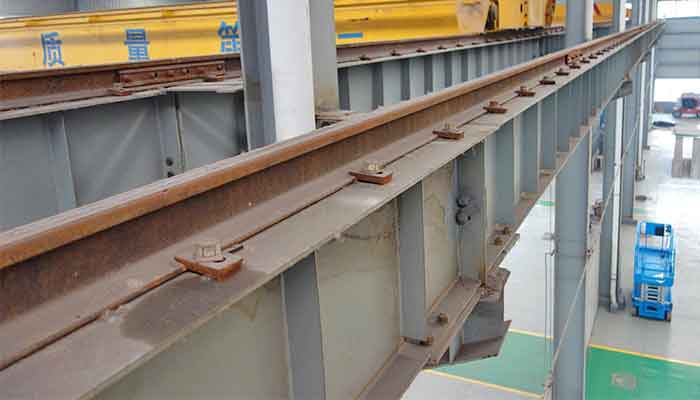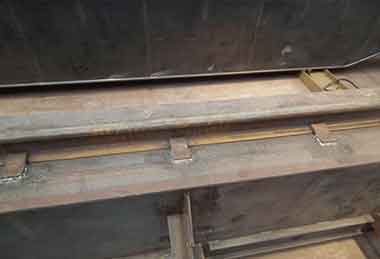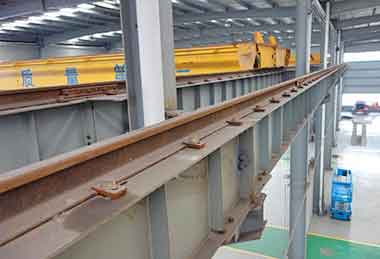
Crane Rail & Track Overview: Types, Specifications & Selections
Classifications of Crane Rails
What are the main types of cranes rails ? In general, there are special rails, rail tracks, square rails, and P-type tracks. The special rails are used for particular needs and application.
Square rails & P type tracks
- The square rails is not so frequently because of their high rate of tire wear. Due to wear on the wheel, square steel with flat top is often only used for lighter loads and slower speeds, where the rail cranes are not frequently used or in operation.
- And P-type rails are now so frequently used so common, no matter on rail cranes or trolleys. The rail has a convex top, a plate with a specific width at the bottom, increasing the contact surface with the base; the track section is I-shaped and has good bending strength.
Heavy crane rail & Light crane rails
Crane rail and crane tracks also can be divided into heavy rail and light rail, and the rail size with a nominal weight per meter length.
- Crane rail with the weight greater than 30kg / m are heavy rail. Standard rail length for heavy crane rail are 12150m and 25100m.
- Light rail general refers to the one that are not more than 30kg / m of the rail, usually with the length of 5 ~ 12m.
For your better understanding, the following crane rail drawings and dimension sizes are presented for your reference. For more details information, please feel free to contact us by WhatsApp: + 151 3871 1597.
Specifications & parameters of crane rails & crane track
Crane rail used for cranes and trolley are with special cross-section and the standard length of crane rails can be grouped into 8 types including 9,915,10,1015,11,1115,12,1215 . The general specifications and parameters are presented for your reference. Any need or doubt, please feel free to contact us.
Model | Top | Bottom | Height | Rail top effective width | Weight/m | Standard | Materials |
50x30 | 50 | 50 | 30 | 38 | 11.8 | KOS-Standard | FE52C |
60x40 | 60 | 60 | 40 | 48 | 19.1 | KOS-Standard | FE52C |
70x40 | 70 | 70 | 40 | 58 | 22.2 | KOS-Standard | FE52C |
80x60 | 80 | 80 | 60 | 68 | 38.6 | KOS-Standard | FE52C |
100x60 | 100 | 100 | 60 | 88 | 47.1 | KOS-Standard | FE52C |
120x80 | 120 | 120 | 80 | 108 | 75.4 | KOS-Standard | FE52C |
P18 | 40 | 80 | 90 | 28.2 | 18.06 | YB222-63 | 55Q |
P24 | 51 | 92 | 107 | 26.13 | 24.95 | YB222-63 | 55Q |
P22 | 50.8 | 93.66 | 93.66 | 34.92 | 22.3 | GB11264-89 | 55Q |
P30 | 60.33 | 107.95 | 107.95 | 44.45 | 30.1 | GB11264-89 | 55Q |
P38 | 68 | 114 | 134 | 43.9 | 38.73 | GB183-63 | U71Mn |
P43 | 70 | 114 | 140 | 46 | 44.65 | GB182-63 | U71Mn |
P50 | 70 | 132 | 152 | 46 | 51.51 | GB181-63 | U71Mn |
QU70 | 70 | 120 | 120 | 58 | 52.8 | GB3426-82 | U71Mn |
QU80 | 80 | 130 | 130 | 64 | 63.69 | GB3426-82 | U71Mn |
QU100 | 100 | 150 | 150 | 84 | 88.96 | GB3426-82 | U71Mn |
QU120 | 120 | 170 | 170 | 104 | 118.1 | GB3426-82 |
Crane rail Dimensions and drawing

P18 Rail
Section Square | 23.07 cm4 |
Weight | 18.06kg/m |
barycenter | X1=4.29cm, X2=4.71cm |
Inertia Moment | Ix=240cm4; Iy=41.1cm4 |

P24 Rail
Section Square | 31.24 cm4 |
Weight | 24.95kg/m |
barycenter | X1=5.305cm, X2=5.395cm |
Inertia Moment | Ix=486cm4; Iy=80.46cm4 |

P38 Rail
Section Square | 49.5 cm4 |
Weight | 38.733kg/m |
barycenter | X1=6.67cm, X2=6.67cm |
Inertia Moment | Ix=1204cm4; Iy=209.3cm4 |

P43 Rail
Section Square | 57cm4 |
Weight | 44.653kg/m |
barycenter | X1=6.85cm, X2=7.15cm |
Inertia Moment | Ix=1489cm4; Iy=260cm4 |

QU70 Rail
Section Square | 67.3cm4 |
Weight | 52.8kg/m |
barycenter | y1=5.93cm, y2=6.07cm |
Inertia Moment | Ix=1081.99cm4; Iy=327.16cm4 |

QU80 Rail
Section Square | 81.13cm4 |
Weight | 63.69kg/m |
barycenter | y1=6.43cm, y2=6.57cm |
Inertia Moment | Ix=1547.4cm4; Iy=482.39cm4 |

QU100 Rail
Section Square | 113.32cm4 |
Weight | 88.96kg/m |
barycenter | y1=7.6cm, y2=7.407cm |
Inertia Moment | Ix=1864.73cm4; Iy=940.98cm4 |

QU120 Rail
Section Square | 150.44cm4 |
Weight | 118.10kg/m |
barycenter | y1=8.43cm, y2=8.57cm |
Inertia Moment | Ix=4923.79cm4; Iy=1694.83cm4 |
Note:
- For P18, P24, P38 rail, we equip fittings with welding platens;
- For P43, QU70, QU80, QU100, QU120, we equip fittings with bolted platens;
- Clamps are equipped with bolts and nuts.
Materials of crane rails
The crane rail is typically made of U71Mn steel. Q275 square steel or flat steel is the most common type of square steel.
In recent years, low-alloy structural steels such as Mn, Si, and P alloy elements have been used to improve the wear resistance and corrosion resistance of steel rails. Different types of crane rails are chosen based on the design and application of overhead rail cranes and gantry rail cranes.

Crane rail certificates

Crane rail certificates

ISO crane rail certificates

ISO crane rail certificates
Overhead crane rail accessories
Crane rail clamps and Crane rail press plate
Crane rail clamps and press plate for overhead crane. All types of cranes and crane accessories are available from us. Our crane rail, crane rail clamps and press plate for sale at good price. Check the overhead crane rail accessories now.
Pressing plates for fastening of the crane rails / crane tracks

Bolted platens

overhead crane rails with Bolted platens

Pressing plates parts

Pressing plates

Bolted platens

Welded platens

Overhead crane with Welded platens
Clamp plates of crane rails and tracks

Crane rail clamp plate with bolts to connect the two rails

Crane rail clamp plate

Press plate and Clamp plate for light type rail as P24,P30
Crane rail joint connection
1. Crane rail joint seam is typically 1 to 2 mm, but it is recommended to use 4 to 6 mm when installed in cold climates or when the temperature is lower than the perpetual usage temperature and differs by more than 20 °C.
2. A crane rail can be joined with a straight head, a 45 degree bevel joint, or an inclined junction that creates a smooth transition connection for the wheel.
3. The height difference and dislocation of the two rails must be smaller than 1 mm.
4. Setting up for welding. Carefully remove any oil contamination and rust, from the groove and the surrounding area before welding the crane rail joint.
5. The welded rail connection sequence is from bottom to top, following the first rail waist rail, rail head, one by one step by step a way for surfacing, and then around the last repair.
6. The issues that need to be resolved during the welding of crane rails.
When welding in each layer when the wave, especially in the welds crane rail bottom of each layer of welding wave, use one finish electrode welding, avoid or move between electrode and arc breaking, 2 layer before and after welding the welds should be the opposite direction of the wave;
Each crane rail joint welding job must be done continuously to keep the end of the rail welding at high temperatures (300 °C 350 °C). After welding, if the eliminating stress prior to heat treatment has not been cooled after heat treatment, rain must be avoided; heat the copper plate can be removed with water cooling, in order to use the next time.
7. Rail connection smooth processing
Crane rail welding joint eliminates stress after heat treatment and cooling to atmospheric temperature, resulting in smooth processing of the track on the top and sides of the weld. When the welding bulge is too large, it will be polished with a grinding wheel polishing machine until flush with the rail head, and then surface ground.
How to select crane rails for your overhead crane & gantry crane?
How to select the right crane rail for your rail travelling overhead crane and gantry crane? Theoretically, the selection of the crane rails are based on a the various factors, including the types of your rail cranes, crane capacity, travelling speed, working duty, crane application environment and rail foundation, etc. For easy understanding, the following table is presented for your reference. Attentions, if you need to select a type of crane rail for your rail cranes, please consults with professional crane engineer or your crane manufacturer or supplier. Any need, please feel free to contact us.
Crane rail and track recommended selection table
Rail crane type | Capacity | Crane Rail recommended |
QD series of rail travelling double girder overhead crane with open winch trolley  | 5t 10t | P38 P43 |
16t 20t | P43 | |
32t | QU70 | |
50t | QU80 | |
75t | QU80 QU100 | |
100t 125t | QU100 | |
160t | QU120 | |
MG types of double girder rail gantry crane with open winch trolley  | 5t 10t 16t 20t | P43 |
32t | QU70 | |
50t 75t | QU80 | |
LD types of electric overhead rail travelling crane  | ≤5t | P24 |
10t | P24 P30 | |
16t | P38 | |
20t | P38 | |
MH type of rail travelling electric double girder gantry crane  | ≤5t | P24 P38 |
10t 16t | P38 P43 | |
MDG type of electric single girder gantry crane rail travelling  | 5t 10t 16t 20t | P43 |
32t 50t | QU70 |
Note:
- 1: The recommended table for track model selection is for your reference and the actual selection can be larger than the recommended track model.Please contact us for more specific suggestion based on your applications and requirements.
- 2: There are two types of tracks recommended. The actual selection can be determined according to the the span or your rail travelling cranes. The smaller the span is, the smaller the rail is. And fthe larger the span. Generally 20 meters as the boundary.
Rail installation for overhead crane
The crane rail is paved on supporting beams for overhead cranes, which include steel beams and concrete beams.
Set the position and altitude according to the overhead crane drawing. Before installing rail, inspect the crane rail's groove, section, straight line, and warp. Once qualified, pave the crane rail. Also, determine the rail datum line.
Crane rail installation on steel bearing beam
If the crane rail is laid on a supporting beam, the deviation between the crane rail center distance and the supporting beam center distance should be less than 10mm and no greater than the beam half thickness.

Pressure plate welded on the steel bearing beam

Bolted on the steel bearing beam
Crane rail is attached to a supporting beam, and the rail bottom should be solely laying on the beam top. If there is space and the length is greater than 200mm, it should be padded; the pad length should be greater than 100mm, and the width should be 10—20mm wider than the rail bottom. Each pad set must have no more than three layers. Pads are welded to the underlying beam.
For general use rail gantry cranes, the deviation between cane rail center distance and installing datum line should be no more than 5mm.
- If the crane span length is less than 10m, the rail center distance can be off by ±3.0 mm.
- .If the crane span exceeds 10m, the rail center distance can vary by ±15 mm..
Following is formula:
△S=±[3+0.25(S-10)] : △S: crane span deviation(mm) S—rail center distance deviation(m)
The crane rail connecting joint should be stagger, the staggered distance is not same as wheel gauge. And on joint, the supporting point should be at span's 1/3~1/4. Crane rail i-beam flange weld bevel butt weld, web has same strength through welding butt weld, after welding, the welding surface is leveling. Artifacts correction for the inclination of the I beam flange delta < / 80 b, b is I beam flange width. Torsion of Angle steel, i-beam vector △h≤L/1000 or less, but shall not be bigger than 5 mm. Local buckling of steel plate rise within a certain range f≤1.5mm.
If a steel plate is crooked, you can fix it with a hammer. There is a particular Jack to do gagging for some structural steel. Heat straightening is an option if it's challenging, but the heat temperature shouldn't be more than 900°C.
The crane rail's end that will be connected by clamps will then have holes made for bolts. You should make holes by mechanical not instead of gas cutting. Bolts cannot be ragged, cracked, or nicked.
Finally, lay the crane rail and fasten it to the supporting beam with bolts or welding. Ultrasonic testing is used to grade the welding.
Crane rail on concrete beam
If the crane rail is built on a concrete beam, a steel plate should be embedded on top of the concrete beam. Crane rail is fixed by an embedded steel plate, similar to gantry crane rail foundation. Other tasks are similar to those listed above.

Concrete craen rail bearing beam

Concrete foundation of the rail bearing beam
Gantry crane rail
When rail travelling gantry cranes are used in a factory, warehouse, or yard, the crane rail is usually sunken in a groove. Gantry crane rail is prominent on the ground for some large working spaces, such as a port or dock. Whatever the condition, there should be a foundation beneath the gantry crane rail to ensure that the ground can bear the gantry cane and wheel Max. loading pressure.
The safety base of gantry crane operation is a solid foundation for gantry crane.

Gantry crane rail foundations

p38 crane rail foundation drawing
Crane Rail Repair Program
Rail inspect and repair for your rail travelling overhead crane and gantry crane is required to ensure crane safety. The following repair tip is appropriate for your rail travelling crane.
1,Remove Existing Crane rails:
Loosen the bolts and nuts for reserve, or gas cut the platens; these platens will be wasted. Hoisting down the crane rail to the ground.
2,Inspect supporting beam:
- a) Check the clearance room from beam top to roof bottom;
- b) Determine the distance between the beam centers on both sides.
- c) Inspect the beam to see if it has sagged or is out of shape between two supporting points.
3,Verify whether the top of the crane rail has less tread or has undergone distortion from friction. And check to see if the crane rail is still straight.
Correctly pave the crane rail and operate your gantry and overhead cranes in a secure manner. For further details about crane rail type, requirements, installation, inspection, and maintenance, please feel free to get in touch with us.



